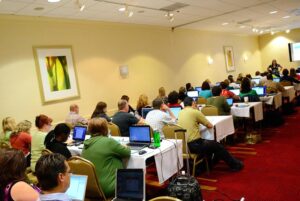
Self-publishing has completely changed the way writers get their work out into the world. With a bit of planning and some tech knowhow, anyone can publish a book, reach readers, and even make a profit. There’s no need to wait for a traditional publisher to say yes. I often meet writers who feel a bit lost on where to start or overwhelmed by all the choices, so I’ve put together this easy-to-follow guide based on my own self-publishing adventure.
Here, you’ll get a walkthrough of the key steps in self-publishing, with my practical tips and lessons I’ve learned along the way. You’ll learn what to expect, how to avoid common mistakes, and how to give your book its best shot at success.
Contents
- 1 Step 1: Know Why You’re Self-Publishing
- 2 Step 2: Complete and Edit Your Manuscript
- 3 Step 3: Format Your Book for Publishing
- 4 Step 4: Design a Cover that Works
- 5 Step 5: Choose Publishing Platforms and Set Up Your Book
- 6 Step 6: Set Up Your Pricing and Royalties
- 7 Step 7: Launch Your Book and Give It the Best Start
- 8 Troubleshooting Common Self-Publishing Problems
- 9 Self-Publishing Success Starts Small
- 10 Related Articles
Step 1: Know Why You’re Self-Publishing
Before getting into the technical steps, it helps to get clear on your main goals. Are you trying to share your story with as many people as possible? Looking to build a side income? Want to boost your credibility in a certain field?
Questions to Ask Yourself:
- Do you want to write fiction, nonfiction, poetry, or something else?
- Is your main goal creative expression, making money, or growing your brand?
- How much time and money are you willing to invest?
- Are you open to learning about marketing, cover design, or formatting?
Your answers will guide your choices when it comes to which publishing platforms to use and how much help you might need.
Step 2: Complete and Edit Your Manuscript
The hardest part for many is finishing the actual writing. Once your manuscript is done, don’t rush to hit “publish” right away—editing is a really important step. Fresh eyes (your own after a break, or a trusted friend) can catch mistakes you didn’t see at first.
Edit Like a Pro:
- Let your manuscript sit for a week or two before you revise. I always find that errors stand out more after a short break.
- Consider hiring a freelance editor. Even a basic proofread can improve your book’s quality and credibility.
- Ask beta readers in your genre for honest opinions. They may catch plot holes or awkward phrases you missed.
Helpful Tools:
- Grammarly (for basic grammar and style checks)
- ProWritingAid (especially if you want deeper analysis)
- Google Docs (easy for sharing drafts with beta readers)
Step 3: Format Your Book for Publishing
Formatting can be a stumbling block for first timers, but there are lots of resources available. The goal is to make your book look professional on both digital devices and print.
Key Formatting Tips:
- Decide if you want to publish as an ebook, paperback, hardcover, or all three.
- KDP (Kindle Direct Publishing) has templates for both paperback and ebook uploads.
- For ebooks, use apps like Calibre or Vellum (Mac only) to help with layouts.
- For print, pay close attention to margins, page numbers, headers, footers, and font size. Print on demand services usually share guidelines and templates on their websites.
Pro Tip:
Download and review your files on an ereader or print a proof copy before making your book live. This extra step can save you a ton of embarrassment later.
Step 4: Design a Cover that Works
The saying “don’t judge a book by its cover” just doesn’t apply here; potential readers will definitely judge yours. A professionallooking cover is one of the best ways to make your book stand out in a crowded marketplace.
Cover Design Options:
- Use a premade cover service. There are many online marketplaces where designers sell readytouse covers at low cost.
- Hire a freelance designer (try Fiverr or Upwork). Share your book’s genre and any themes that might influence the design.
- Try DIY tools like Canva if you feel confident with simple design work. Just make sure you understand the correct size and file formats required by platforms like Amazon.
What Makes a Good Cover?
- Clear, readable title text (even at thumbnail size)
- High resolution images (at least 300 dpi for print)
- Designs that match your genre and target audience expectations
Step 5: Choose Publishing Platforms and Set Up Your Book
Selfpublishers have access to several major platforms. Each one has pros, cons, and little rules, so it helps to do a sidebyside comparison based on your needs.
Popular Platforms:
- Amazon Kindle Direct Publishing (KDP): Most popular for ebooks and print on demand paperbacks. Reaches a massive global audience.
- Apple Books, Barnes & Noble Press, Kobo: Great for reaching readers with nonKindle devices.
- IngramSpark: Good for wide print distribution, including independent bookstores and libraries.
Some authors stick with KDP Select for its marketing perks, but doing so means your ebook is exclusive to Amazon for a set period. If you’d rather have more flexibility, you might want to publish “wide” (across lots of platforms).
Account Setup Steps:
- Register for a free publishing account on your chosen platform(s).
- Fill in your author details for the book’s metadata (title, subtitle, book description, genres, keywords, and author bio).
- Upload formatted manuscript and cover files as required.
- Set up pricing, territories, and choose royalty options. This part is usually pretty straightforward in the platform dashboards.
Step 6: Set Up Your Pricing and Royalties
Picking a price isn’t always easy. If you price too high, it might scare away new readers; too low, and you might not reach your income goals. I’ve found it helps to look at what similar books in your genre and length are selling for, then make small changes over time based on sales and reviews.
What Matters for Pricing:
- Length and genre (short stories or poetry usually sell for less than long novels)
- Your main goal (spreading your story, or earning more per sale?)
- Platform minimums and royalty split
- Sales promotions or free/discounted launches
Print on demand books have production costs, so read each platform’s royalty calculator before setting your price. Remember, adjusting your price later is no problem, and many indie authors experiment until they find the sweet spot for their audience.
Step 7: Launch Your Book and Give It the Best Start
Pushing the “publish” button feels amazing, but the work doesn’t totally end there. Getting those first few sales and reviews is super important for building momentum. A great launch strategy isn’t just about shouting “buy my book”—it’s about sharing your author story and making genuine connections with readers.
How to Promote a New Book:
- Ask friends, family, and any early readers for reviews right away. Reviews help your book get noticed and build reader trust.
- Use social media (Instagram, Twitter, TikTok, Facebook) to tell your story and talk about your book’s adventure. Give sneak peeks, share behindthescenes moments, or hold a Q&A live stream.
- Consider a book launch newsletter if you have an email list, or use free email services like Mailchimp.
- Offer a discount or free download period to boost visibility. You can do this through Amazon KDP promotions or sites like BookBub.
- Look for podcast or blog interview opportunities related to your genre. This can really help get the word out to new audiences.
Check out sites like Reedsy and Self Publishing Advice for up-to-date tips on launches and book marketing. Also, don’t hesitate to join a community of indie writers to ask questions, swap ideas, and support each other during launches.
Troubleshooting Common Self-Publishing Problems
My book isn’t selling. What should I do?
Try tweaking your categories and keywords, experiment with pricing, and check if your cover really fits your genre. Sometimes, small changes can bring in more eyes. It might help to join author forums and ask for honest feedback from fellow writers.
I keep running into formatting errors.
- Double-check your platform’s publishing guidelines thoroughly because some small detail might be missing.
- Try exporting your file as PDF or EPUB from different software to spot issues that didn’t show up in your first pass.
- Reach out to freelance formatters or professional services if tech glitches keep happening; their quick help can save time and stress going forward.
I’m overwhelmed by marketing and don’t know where to start.
Focus on one area (like Instagram or an email newsletter) and build slowly from there. Networking with other indie authors in Facebook groups or forums can be a great source of ideas and support. Remember, you don’t have to do everything at once—consistency and authenticity matter more than being everywhere at the same time.
Self-Publishing Success Starts Small
Breaking into self-publishing is a stepbystep process. Each stage gets easier with practice, and every finished book boosts your confidence for the next. Keep tracking your progress, keep learning, and remind yourself that every new release is a learning opportunity. If you stick with it, share your progress, and keep learning, you’ll find the self-publishing path can be both rewarding and surprisingly fun. Plus, you might even meet readers and other writers who inspire you in new ways.
Your Turn:
- Decide on your self-publishing goal. Do you want to share, earn, or both?
- Finish and polish your manuscript, then prep it for release. Don’t forget to celebrate your completed draft; that’s a huge milestone!
- Pick your publishing platform, upload your files, and get ready for your launch. Reach out if you need tips or support along the way.
What’s the book idea you’ve always wanted to publish? I’d love to hear about it in the comments, or reach out to chat if you have questions about any of these steps. Even if you’re just brainstorming or thinking things through, this could be your first big step toward making your author dreams happen!
Related Articles







